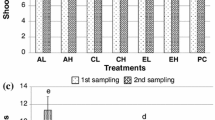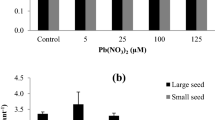Abstract
Fluorine (F) is widely distributed in soils and is not an essential element for the normal growth of a plant, but in higher concentrations, it is toxic. However, the environmental toxicity of F in soils is still controversial. A pot experiment of broad bean and maize under the exposure to F was performed to elucidate F phytotoxicity and the response of the microbial community in soils. Six different levels (0, 200, 400, 600, 800, and 1000 mg kg–1) of sodium fluoride were spiked into the soil. The results revealed that the height of stem and root decreased with increasing concentration of F. Germination rate and fresh weight showed no difference in different treatments. At the treatment of 1000 mg kg−1 F, the degradation rates of pigments were 30.6%, 42.9%, and 35.7% for chlorophyll a, chlorophyll b, and total chlorophylls compared with control, respectively. All treatments showed a higher level of F accumulation in root than that in stem and leaf, and stem had a minimum F accumulation. Proteobacteria was the dominant species in bacteria and the relative abundance of Proteobacteria declined significantly with F exposure. Moreover, the number of microbial species both in bacteria and fungus was reduced for the increase of F. In general, our results revealed that high concentrations of F inhibited the growth of broad bean and maize but without visual symptom. The effect of fluorine on broad bean and maize is clarified in the present study which is instructive for agricultural safety.







Similar content being viewed by others
References
Abdallah, F. B., Elloumi, N., Megfani, I., Garrec, J. P., Sfax, M. B., & Tunisia, M. (2006). Fluoride pollution of Jerbi grape leaves and the distribution of F, Ca, Mg and P in them. Fluoride, 39, 43–48.
Arnesen, A. K. M. (1997). Availability of fluoride to plants grown in contaminated soils. Plant and Soil, 191, 13–25.
Bao, S. D. (2000). Soil agrochemical analysis. Beijing: China Agriculture Press.
Bhargava, D., & Bhardwaj, N. (2010). Effect of sodium fluoride on seed germination and seedling growth of Triticum aestivum var. Raj. 4083. Journal of Phytology, 2(4), 41–43.
Cronin, S. J., Manoharan, V., Hedley, M. J., & Loganathan, P. (2000). Fluoride: a review of its fate, bioavailability, and risks of fluorosis in grazed-pasture systems in New Zealand. New Zeal J Agr Res, 43, 295–321.
Davison, A. W., & Weinstein, L. H. (2006). Chapter 8: Some problems relating to fluorides in the environment: effects on plants and animals. Advances in Fluorine Sci, 1, 251–298.
Elloumi, N., Abdallah, F. B., Mezghani, I., Rhouma, A., & Boukhrisb, M. (2005). Effect of fluoride on almond seedling in culture solution. Fluoride, 38(3), 193–198.
Emerson, W. W., & Greenland, D. J. (1990). Soil aggregates—formation and stability. In M. F. De Boodt, M. H. B. Hayes, A. Herbillon, E. B. A. De Strooper, & J. J. Tuck (Eds.), Soil Colloids and Their Associations in Aggregates. Boston: Springer.
Fuge, R. (2019). Fluorine in the environment, a review of its sources and geochemistry. Applied Geochemistry, 100, 393–406.
Gadi, B., Bhati, K., Goswami, B., Rankawat, R., Kumar, S., Kumar, R., Ram, A., Pooja, V., Laxmi, V., & Singariya, P. (2016). Sources and phytotoxicity of fluorides in the environment. In B. R. Bamniya & B. R. Gadi (Eds.), Environmental impact on biodiversity (pp. 251–266). New Delhi: Today & Tomorrow’s Printers and Publishers.
Gan, C. D., Jia, Y. B., & Yang, J. Y. (2021). Remediation of fluoride contaminated soil with nano hydroxyapatite amendment: response of soil fluoride bioavailability and microbial communities. Journal of Hazardous Materials, 405, 124694.
Gao, H. J., Zhang, Z. Z., & Wan, X. C. (2012). Influences of charcoal and bamboo charcoal amendment on soil fluoride fractions and bioaccumulation of fluoride in tea plants. Environmental Geochemistry and Health, 34, 551–562.
Garstka, T. A., Hummert, M. L., & Branscombe, N. R. (2005). Preceiving age discrimination in response to intergenerational inequity. Journal of Social Issues, 61, 321–342.
Gupta, S., Banerjee, S., & Mondala, S. (2009). Phytotoxicity of fluoride in the germination of paddy (Oryza sativa ) and its effect on the physiology and biochemistry of germinated seedlings. Fluoride, 42(2), 142–146.
Herlemann, D. P., Labrenz, M., Jurgens, K., Bertilsson, S., Waniek, J. J., & Andersson, A. F. (2011). Transitions in bacterial communities along the 2000 km salinity gradient of the Baltic Sea. The ISME Journal, 5(10), 1571–1579.
Horner, J. M., & Bell, J. N. B. (1995). Effects of fluoride and acidity on early plant growth. Agriculture Ecosystems and Environment, 52, 205–211.
Jha, S. K., Nayak, A. K., & Sharma, Y. K. (2009). Fluoride toxicity effects in onion (Allium cepa L.) grown in contaminated soils. Chemosphere, 76, 353–356.
Jha, S. K., Sharma, Y. K., Damodaran, T., Mishra, V. K., & Sharma, D. K. (2013). Bioconcentration of fluoride in lady’s finger (Abelmoschus esculentus) grown in contaminated alkaline soil and evaluation of exposure risk in human. Toxicological and Environmental Chemistry, 95(1), 138–141.
Kabata, P. A., & Pendias, H. (2001). Trace elements in soils and plants. Florida: CRC press.
Kamaluddin, M., & Zwiazek, J. J. (2003). Fluoride inhibits root water transport and effects on leaf expansion and gas exchange in Aspen (Populus tremuloides) seedlings. Physiologia Plantarum, 117(3), 368–375.
Keller, T. (1980). The simultaneous effect of soil-borne NaF and air pollutant SO2 on CO2-uptake and pollutant accumulation. Oecologia, 44, 283–285.
Koblar, A., Tavčar, G., & Ponikvar-Svet, M. (2015). Stress syndrome response of nettle (UrticadioicaL.) grown in fluoride contaminated substrate to fluoride and fluorine accumulation pattern. Journal of Fluorine Chemistry, 172, 7–12.
Kumar, S., & Singh, M. (2015). Effect of fluoride contaminated irrigation water on eco-hysiology, biomass and yield in Gossypium hirsutum L. Trop. Plant Res, 2(2), 134–142.
Larsen, S., & Widdowson, A. E. (1971). Soil fluorine. Journal of Soil Science, 22, 210–221.
Li, Y. P., Wang, S. L., Nan, Z. R., Zang, F., Sun, H. L., Zhang, Q., Huang, W., & Bao, L. L. (2019). Accumulation, fractionation and health risk assessment of fluoride and heavy metals in soil-crop systems in northwest China. Sci. Total Environ., 663, 307–314.
Malde, M. K., Bjorvatn, K., & Julshamn, K. (2001). Determination of fluoride in food by the use of alkali fusion and fluoride ion-selective electrode. Food Chemistry, 73, 373–379.
Mandinic, Z., Curcic, M., Antonijevic, B., Carevic, M., Mandic, J., DjukicCosic, D., & Lekic, C. (2010). Fluoride in drinking water and dental fluorosis. Sci Total Environ, 408, 3507–3512.
Marquis, R. E., Clock, S. A., & Marilaine, M. M. (2002). Fluoride and organic week acids as modulators of microbial physiology. FEMS Microbiology Reviews, 26, 493–510.
Mcquaker, N. R., & Gurney, M. (1977). Determination of total fluoride in soil and vegetation using an alkali fusion-selective ion electrode technique. Analytical Chemistry, 49, 73–77.
Mei, H. B., Remete, A. M., Zou, Y. P., Moriwaki, H., Fustero, S., Kiss, L., Soloshonok, V. A., & Han, J. L. (2020). Fluorine-containing drugs approved by the FDA in 2019. Chinese Chem Lett.
Mondal, N. K. (2017). Effect of fluoride on photosynthesis, growth and accumulation of four widely cultivated rice (Oryza sativa L.) varieties in India. Ecotox Environ Safe, 144, 36–44.
Ochoa-Herrera, V., Banihani, Q., León, G., Khatri, C., Field, J. A., & Sierra-Alvarez, R. (2009). Toxicity of fluoride to microorganisms in biological wastewater treatment systems. Water Research, 43, 3177–3186.
Omueti, J. A. I., & Jones, R. L. (1977). Fluoride adsorption by Illinois soils. Journal of Soil Science, 28, 564–572.
Poulsen, R. (2011). The effect of fluoride pollution on soil microorganisms. University of Iceland.
Ropelewska, E., Dziejowski, J., & Zapotoczny, P. (2016). Changes in the microbial activity and thermal properties of soil treated with sodium fluoride. Applied Soil Ecology, 98, 159–165.
Saini, P., Khan, S., Baunthiyal, M., & Sharma, V. (2013). Effects of fluoride on germination, early growth and antioxidant enzyme activities of legume plant species Prosopis juliflora. Journal of Environmental Biology, 34, 205–209.
Sreedevi, R., & Damodharam, T. (2013). Exterminate consequence of consequence of NaF on seed germination and some morphological changes of major pulse crop Cicer aritinum L.Cv. Anuradha (Bengal gram). Asian J Plant Sci Res, 3(2), 38–41.
Stevens, D. P., McLaughlin, M. J., Randall, P. J., & Keerthisinghe, G. (2000). Effect of fluoride supply on fluoride concentrations in five pasture species: Levels required to reach phytotoxic or potentially zootoxic concentrations in plant tissue. Plant and Soil, 227, 223–233.
Sugiyama, A., Masuda, S., Nagaosa, K., Tsujimura, M., & Kato, K. (2018). Tracking the direct impact of rainfall on groundwater at Mt. Fuji by multiple analyses including microbial DNA. Biogeosciences, 15, 721–732.
Wang, M., Li, X., He, W. Y., Liao, Y. L., Li, J. X., Zhu, Y. Y., Yang, J. Y., & Yang, X. E. (2019). Distribution, health risk assessment, and anthropogenic sources of fluorine in farmland soils in phosphate industrial area, southwest China. Environmental Pollution, 249, 423–433.
Weinstein, L. H., & Davison, L. H. (2004). Fluorides in the environment: effects on plants and animals. Wallingford, UK: CABI.
Wellburn, A. R. (1994). The spectral determination of chlorophylls a and b, as well as total carotenoids, using various solvents with spectrophotometers of different resolution. Journal of Plant Physiology, 144, 307–313.
Wenzel, W. W., & Blum, W. E. H. (1992). Fluorine speciation and mobility in F-contaminated soil. Soil Science, 153, 357–364.
Xu, L., Cui, H., Zheng, X., Zhou, J., Zhang, W., Liang, J., & Zhou, J. (2017). Changes in the heavy metal distributions in whole soil and aggregates affected by the application of alkaline materials and phytoremediation. RSC Advances, 7, 41033–41042.
Yang, J. Y., Wang, M., Jia, Y. B., Gou, M., & Zeyer, J. (2017). Toxicity of vanadium in soil on soybean at different growth stage. Environmental Pollution, 231, 48–58.
Zhang, J., Huang, W., & Zhou, Q. (2014). Reflectance variation within the in-chlorophyll centre waveband for robust retrieval of leaf chlorophyll content. PLoS One, 9, e110812.
Zouari, M., Ahmed, C.B, Fourati, R., Delmail, D., Rouina, B.B., Labrousse, P., Abdallah, F.B., (2014). Soil fluoride spiking effects on olive trees (Olea europaea L. cv. Chemlali). Ecotox Environ Safe, 108:78–83.
Funding
This work was supported by the Chengdu Science and Technology Project (2018-YF05-00760-SN), the Sichuan University Foreign Culture and Education Expert Program (G20190023075), and the Strategic Cooperation Project Between Sichuan University and Yibin Municipal Government (2019CDYB-19).
Author information
Authors and Affiliations
Corresponding author
Ethics declarations
Conflict of interest
The authors declare that they have no conflict of interest.
Human and animal rights and informed consent
This article does not contain any studies with human participants or animals performed by any of the authors.
Additional information
Publisher’s Note
Springer Nature remains neutral with regard to jurisdictional claims in published maps and institutional affiliations.
Rights and permissions
About this article
Cite this article
Cui, Sf., Yang, Jy. Effects of Fluorine on the Growth of Broad Bean (Vicia faba L.) and Maize (Zea mays L.) and the Response of Microbial Community in Soils. Water Air Soil Pollut 232, 27 (2021). https://doi.org/10.1007/s11270-021-04983-x
Received:
Accepted:
Published:
DOI: https://doi.org/10.1007/s11270-021-04983-x




